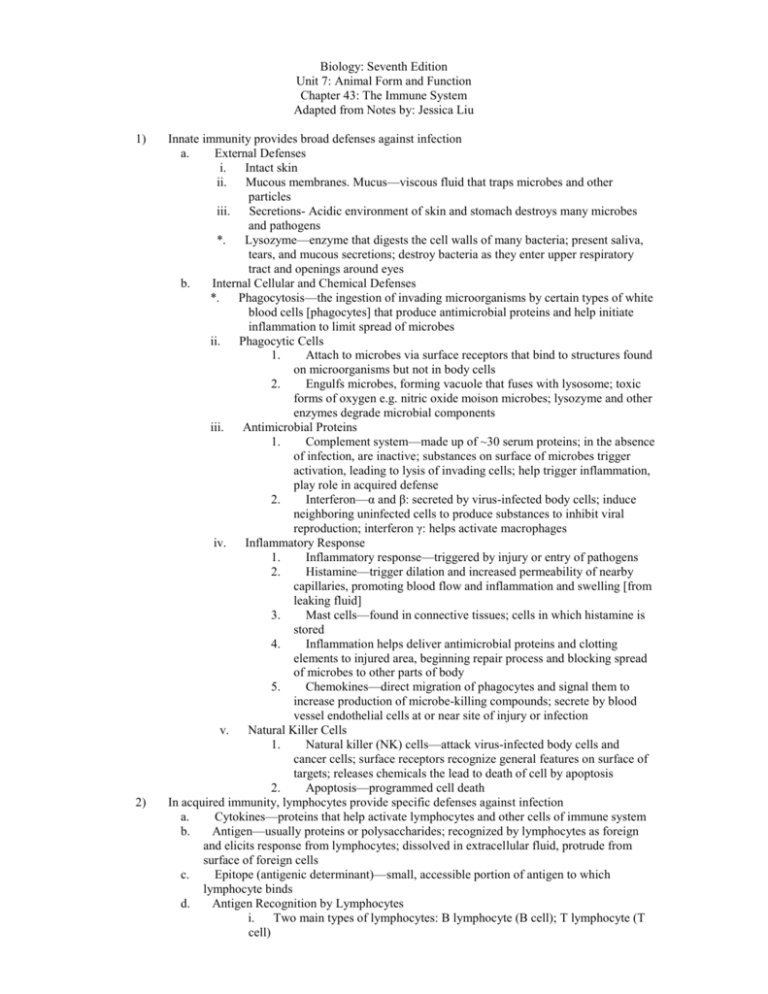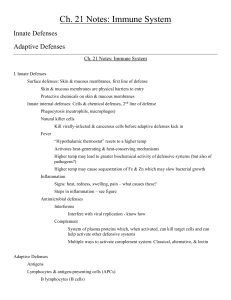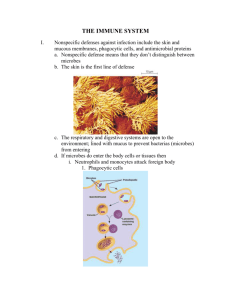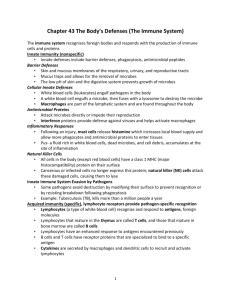Chapter 43: Immune System
advertisement

Biology: Seventh Edition Unit 7: Animal Form and Function Chapter 43: The Immune System Adapted from Notes by: Jessica Liu 1) 2) Innate immunity provides broad defenses against infection a. External Defenses i. Intact skin ii. Mucous membranes. Mucus—viscous fluid that traps microbes and other particles iii. Secretions- Acidic environment of skin and stomach destroys many microbes and pathogens *. Lysozyme—enzyme that digests the cell walls of many bacteria; present saliva, tears, and mucous secretions; destroy bacteria as they enter upper respiratory tract and openings around eyes b. Internal Cellular and Chemical Defenses *. Phagocytosis—the ingestion of invading microorganisms by certain types of white blood cells [phagocytes] that produce antimicrobial proteins and help initiate inflammation to limit spread of microbes ii. Phagocytic Cells 1. Attach to microbes via surface receptors that bind to structures found on microorganisms but not in body cells 2. Engulfs microbes, forming vacuole that fuses with lysosome; toxic forms of oxygen e.g. nitric oxide moison microbes; lysozyme and other enzymes degrade microbial components iii. Antimicrobial Proteins 1. Complement system—made up of ~30 serum proteins; in the absence of infection, are inactive; substances on surface of microbes trigger activation, leading to lysis of invading cells; help trigger inflammation, play role in acquired defense 2. Interferon—α and β: secreted by virus-infected body cells; induce neighboring uninfected cells to produce substances to inhibit viral reproduction; interferon γ: helps activate macrophages iv. Inflammatory Response 1. Inflammatory response—triggered by injury or entry of pathogens 2. Histamine—trigger dilation and increased permeability of nearby capillaries, promoting blood flow and inflammation and swelling [from leaking fluid] 3. Mast cells—found in connective tissues; cells in which histamine is stored 4. Inflammation helps deliver antimicrobial proteins and clotting elements to injured area, beginning repair process and blocking spread of microbes to other parts of body 5. Chemokines—direct migration of phagocytes and signal them to increase production of microbe-killing compounds; secrete by blood vessel endothelial cells at or near site of injury or infection v. Natural Killer Cells 1. Natural killer (NK) cells—attack virus-infected body cells and cancer cells; surface receptors recognize general features on surface of targets; releases chemicals the lead to death of cell by apoptosis 2. Apoptosis—programmed cell death In acquired immunity, lymphocytes provide specific defenses against infection a. Cytokines—proteins that help activate lymphocytes and other cells of immune system b. Antigen—usually proteins or polysaccharides; recognized by lymphocytes as foreign and elicits response from lymphocytes; dissolved in extracellular fluid, protrude from surface of foreign cells c. Epitope (antigenic determinant)—small, accessible portion of antigen to which lymphocyte binds d. Antigen Recognition by Lymphocytes i. Two main types of lymphocytes: B lymphocyte (B cell); T lymphocyte (T cell) 3) ii. Circulate through blood, concentrated in spleen, lymph nods, lymphoid tissues; iii. Antigen receptors—antigen-specific receptors in plasma membrane of lymphocyte; all of ~100,000 on a cell are identical—specificity for epitope on an antigen and defends against that antigen and closely related antigens iv. B Cell Receptors for Antigens 1. B Cell receptor (membrane antibodies, membrane immunoglobulins)—Y-shaped molecule consisting of four polypeptide chains: two heavy chains [identical], two light chains linked by disulfide bridge 2. Transmembrane region anchors receptor in plasma membrane, short region of tail extends into cytoplasm 3. Variable (V) regions—regions at tips of Y light and heavy chains; vary from one B cell to another; form antigen-binding site 4. Constant (C) regions—everything not in V region; almost the same in all cells 5. Bonding between antigen binding site and antigen by noncovalent bonds between chemical groups v. T Cell Receptors for Antigens and the Role of the MHC 1. T cell receptor—consists of α-chain, β-chain linked by disulfide bridge; transmembrane region anchors molecule in plasma membrane; V regions for single antigen-binding site; recognize fragments of antigens bound to normal MHC surface proteins 2. Major histocompatibility complex (MHC)—family of genes that codes for MHC molecule, which performs antigen presentation a. Class I MHC molecules—found on almost all nucleated cells of body; bind peptides from foreign antigens that have been synthesized within cell e.g. in cancer cells; when bound to antigens, are recognized by cytotoxic T cells b. Class II MHC molecules—made by dendritic cells, macrophages, B cells; bind peptides derived from foreign material that have been internalized or fragmented through pagocytosis or endocytosis; antigen-presenting cells— dendritic cells, macrophages, B cells; display internalized antigens to helper T cells 3. Antigen Presentation—MHC molecule binds with fragment of protein antigen within cell and brings it to cell surface as it moves toward plasma membrane 4. Because of many different MHC alleles, most people are heterozygous for all MHC genes and can produce broad array of MHC molecules; two people unlikely to have same set of MHC molecules chemical fingerprint of individual; marks cells as “self” e. Lymphocyte Development i. Thymus—gland in thoracic cavity above heart where lymphocytes develop to T cells ii. B cells mature in bone marrow iii. Clonal Selection of Lymphocytes 1. “Selection” of B cell or T cell by antigen activates lymphocyte and causes it to divide, forming two clones of daughter cells 2. Effector cells—combat antigen; short-lived 3. Memory cells—bear receptors specific for same inducing antigen; long-lived 4. Clonal selection—antigen-driven cloning of lymphocytes 5. Primary immune response—proliferation of lymphocytes the first time the body is exposed to a particular antigen; peak 10 to 17 days after initial exposure 6. Plasma cells—antibody-secreting effector B cells 7. Secondary immune response—faster, more prolonged response the second time the body is exposed to antigen 8. Immunological memory—immune system’s ability to generate secondary immune response; depends on clones of memory T and B cells Humoral and cell-mediated immunity defend against different types of threats a. b. c. d. e. f. Humoral immune response—activation and clonal selection of B cells Cell-mediated immune response—activation and clonal selection of cytotoxic T cells Helper T cell—responds to peptide antigens displayed on antigen-presenting cells and stimulates activation of B cells and cytotoxic T cells Helper T Cells: A Response to Nearly All Antigens i. Helper T cell recognizes class II MHC molecule-antigen complex on antigen presenting cell proliferates into active helper T cell clone and memory helper T cell ii. CD4—binds class II MHC molecule to keep helper T cell and antigenpresenting cell joined while activation of helper T cell proceeds iii. Active helper T cells secrete cytokines that stimulate other lymphocytes to promote humoral and cell-mediated response iv. Naïve helper T cells—helper T cells that have not yet detected antigen; v. Macrophages present antigens to memory T cells; B cells present antigens to helper T cells in humoral response Cytotoxic T Cells: A Response to Infected Cells and Cancer Cells i. Cytotoxic T cells eliminate infected body cells ii. Nonself proteins synthesized in target cells associate with class I MHC molecule and are displayed on cell surface to be recognized by cytotoxic T cell iii. CD8—binds to class I MHC molecule keeps target cell and cytotoxic T cell in contact during activation of cytotoxic T cell iv. When cytotoxic T cell binds to MHC molecule-antigen complex it differentiates and becomes active killer; process promoted by cytokines from nearby helper T cells v. Activated cytotoxic T cell secretes proteins that lead to its destruction vi. Perforin—forms pores in target cell membrane vii. Granzyme—proteolytic enzyme that enters target cell by endocytosis; initiate apoptosis and lead to fragmentation of nucleus release of apoptotic bodies B Cells: A Response to Extracellular Pathogens i. B cell takes in antigen from surface of B cell by endocytosis and presents it to helper T cell; T cell bearing receptor for antigen bind to B cell, secrete cytokines to activate B cell ii. B cell stimulated by antigen and cytokines proliferates and differentiates into clone of plasma cells and memory B cells iii. Macrophage and dendritic cell can present peptide fragments from wide variety of antigens, but B cell binds and presents only antigen to which it specifically bonds iv. T-dependent antigens—antigens that induce antibody production only with assistance from helper T cells v. T-independent antigens—can evoke B cell response without involvement of helper T cells; e.g. polysaccharides of many bacterial capsules, proteins from bacteria flagella; generally weaker response, no memory B cells vi. Antibody Classes 1. Immunoglobulins a. IgM (pentamer)—first Ig class produced after initial exposure to antigen, then concentration declines; promotes neutralization and agglutination of antigens; effective in complement activation b. IgG (monomer)—most abundant in blood, present in tissue fluid; only Ig class that crosses placenta, confers passive immunity on fetus; promotes opsonization, neutralization, agglutination of antigens, less effective in complement activation c. IgA (dimer)—present in secretions; provides localized defense of mucous membranes by agglutination and neutralization of antigens; J-chain + secretory component d. IgE (monomer)—triggers release of histamine from mast cells and basophils that cause allergic reactions e. IgD—present on surface of naïve B cells that have not been exposed to antigens; acts as antigen receptor in clonal selection of B cells vii. Antibody-Mediated Disposal of Antigens 1. 4) 5) Binding of antibodies to antigens inactivates antigens by: a. Viral neutralization—block binding to host; opsonization— increases phagocytosis by increasing macrophage attachment to microbes b. Agglutination—clumping of antigen bearing particles, possible because each antibody molecule has at least 2 antigen binding sites that can bind to identical epitopes on different particles to link them together c. Precipitation—antibodies cross-link soluble antigen molecules; form immobile aggregate d. Membrane attack complex (MAC)—forms pore in membrane, cause cell to swell and lyse when complement system activated 2. Neutralization, opsonization, agglutination, precipitation enhance phagocytosis 3. Activation of complement system causes cell lysis g. Active and Passive Immunization i. Active immunity—immunity conferred by natural exposure to infectious agent; depends on activation of person’s own lymphocytes and resulting memory cells ii. Immunization (vaccination)—develops active immunity; include inactivated bacterial toxins, killed microbes, weakened microbes to induce immediate immune response and immunological memory through memory cells quick secondary response iii. Passive immunity—achieve immunity by transfer antibodies from immune individual to non-immune individual; does not result from action of recipient’s B and T cells; antibodies received immediately help destroy microbes; last only as long as transferred antibodies live; occurs naturally in transfer of antibodies from mother to child to protect infant against infection while their immune system is maturing; occurs artificially in treatment of rabies The immune system’s ability to distinguish self from nonself limits tissue transplantation a. Blood Groups and Transfusions i. A type blood: Anti-B antibodies; B type: Anti-A; AB type: No anti-A or anti-B; O type: Anti-A and Anti-B ii. O is universal donor; AB is universal recipient iii. Antigens against foreign blood type present even in absence of exposure to foreign blood type because antibodies arise in response to normal bacterial inhabitants of body iv. Anti blood group antibodies are always IgM; no memory cells generated v. Rh factor—induces immune response in which memory cells generated; later exposure leads to anti-Rh IgG antibodies Exaggerated, self-directed, or diminished immune responses can cause disease a. Allergies i. Allergens—antigens that in exaggerated response cause allergies; commonly involve IgE ii. Degranulation—mast cells release histamine and inflammatory agents against pollen iii. Histamine increases permeability of small blood vessels iv. Antihistamines block histamine receptors v. Anaphylactic shock—whole-body, life-threatening reaction; occurs when widespread degranulation by mast cells causes blood vessel dilation, sudden drop in blood pressure; can be countered by epinephrine b. Autoimmune Diseases i. Autoimmune diseases—immune system turns against self ii. Autoimmune disease arise from failure in immune system regulation c. Immunodeficiency Diseases i. yeah like AIDS and stuff.








